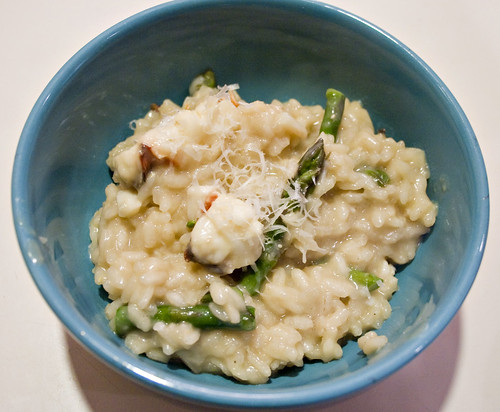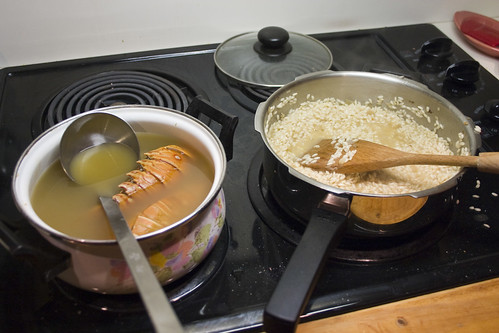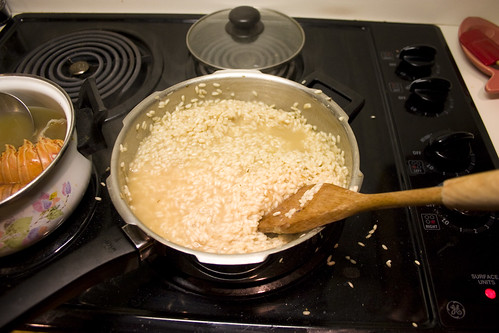
We did our "fancy" dinner on Christmas Eve (prime rib roast, garlic mashed potatoes, roasted asparagus). I had also bought some lobster tails with the intention of making it more of a "surf & turf" dinner, but at the last minute, I realized that we already had a ton of food. So I decided instead to save the lobster for Christmas day.
Well, as dinner approached, I realized I had no clue what to do with two small-ish lobster tails, other than the boring old steam or broil, followed by dunking in copious amounts of butter, which I'm honestly not a huge fan of anyways. As I rooted around in the fridge and pantry, I remembered that I'd had a jones for risotto a couple weeks ago and decided to go ahead and make some at the last minute.
Risotto is one of those things that sounds really fancy and hard to make, but it's basically just rice and broth and whatever else you want to add to it. It's not hard to make, just time-consuming. Ever since I learned how to make it, I almost never order it in a restaurant anymore.
Ingredients
2 T. olive oil
2 T. butter
3/4 c. finely chopped shallots
2 c. uncooked arborio rice
1/2 c. white wine
2 qts good quality low-sodium chicken stock or broth
1 lb. asparagus
2 small-medium lobster tails (mine were 3/4 lb total)
1-2 T. butter
2 T. cream (optional)
1/4 c. shredded Parmesan
salt & pepper to taste
Directions
1. Trim the woody ends off of the asparagus and reserve. Cut the rest into 1-2 inch pieces.
2. Remove lobster from shell, reserving shell. Cut lobster into large chunks.
3. Heat up chicken stock in a separate pot. Add asparagus trimmings and lobster shells. This will give your stock a boost of lobster & asparagus flavor. Hot stock is key to making risotto. Cold or room temperature stock will lower the overall temperature of your risotto and take much longer to cook. It'll also affect the texture.
4. Heat large pan over medium-high heat. Add oil and butter and shallots. Saute shallots until translucent. Add rice and saute until grains start to become translucent around edges.
5. Add white wine. Scrape up any bits that may have stuck to the bottom of the pan and stir until it has reduced by about half.
6. And now, start adding stock and stir, stir stir.

Make sure your heat is not up too high, as you want the rice to absorb the stock slowly. You want it to be a little above a simmer, otherwise, the outside will cook too quickly and the inside will remain raw. The reason you have to keep stirring is that you also want the rice to release its starch. This is what gives risotto its lovely creamy texture.
I generally add about a half cup of stock at a time (I have a 4 oz. ladle which makes this easy to measure). You want to cook until the rice has absorbed most of the liquid before adding more. I find that this happens more quickly in the beginning, and more slowly towards the end. It may also help you to taste the rice frequently as it cooks, so you can get a sense of the different levels of doneness.
Just to give you an idea of when it's time to add more stock, if while stirring, you can see the bottom of the pan for more than a couple seconds, it's time.

Add just enough stock to make it loose and slightly soupy. Again, don't drown it. You don't want to boil the rice.

Then, like before, keep stirring. In total, it should take about 20-25 minutes.
7. Once you feel like your rice is getting close to done, add the chopped asparagus and lobster pieces. Continue to stir and add stock, as necessary, until everything is cooked. You may or may not use all the stock. It all depends on your rice.

Oh, one other warning: make sure your pan is big enough as the rice will double, if not triple, in volume. I usually don't make this much, so I foolishly thought I'd be able to get by with a smaller pan but then had to switch to a larger one about halfway through.
8. The rice is done when it's tender, but still has a little bit of bite to it. Once it's reached that point, but still has a little bit of excess liquid, turn off your heat, and stir in a nice healthy knob of butter. One-two tablespoons should do it. You could also add a splash of heavy cream, if you like.
9. Last, but not least grate some fresh Parmesan over the whole thing. I usually subscribe to the school that Parmesan and seafood do not belong together, but I make an exception for risotto. To me, it just isn't the same without a little of that sharp tang that Parmesan adds.
10. Season to taste with salt and pepper and serve immediately, garnished with a little more Parmesan.
Serves 4 as main course, 8 as a side dish
Notes
You could easily halve or double this recipe. It's pretty much the same amount of work, regardless of the amount. You could also substitute shrimp or some other shellfish for the lobster, or leave it out entirely. The lobster meat did break up a bit as a result of all the stirring, but I actually didn't mind since it meant there were bits of lobster in almost every bite. I also used leftover champagne from our morning mimosas in lieu of white wine. It was a very decadent meal. ;)
I'm sure there are way better tutorials out there on how to make risotto, and I largely improvised this recipe on the fly, so I apologize if the directions are less than crystal clear. Feel free to post any questions in the comments section and I'll do my best to clarify as needed.



No comments:
Post a Comment